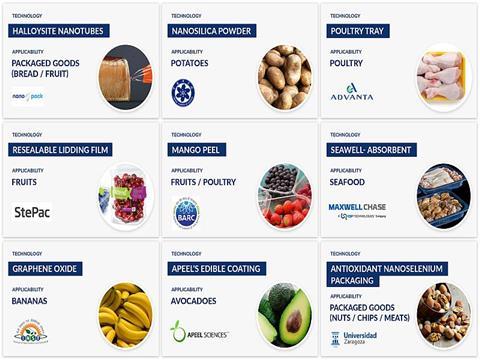
By Paula Hock, Project Architect, PreScouter
Every consumer at one point or another has struggled with the limitations of food and beverage packaging. Picture it: coming home and opening the refrigerator intending to use those beautiful bell peppers to satisfy the fajita craving, but upon peering into the produce drawer, there’s a mouldy mess where peppers should be. Guess it will have to be takeout again.
Solving such a problem would be any packaging producer’s dream: consumers choose your product (or your client’s product) again and again knowing that their food will remain fresh and usable longer than the others on the shelf. While it sounds like a pipe dream, advancements in the area of extending shelf life reach ever-closer to such an ideal. The question is, whose packaging will reign supreme in the coming months?
This report published by PreScouter, Inc. explored a selection of the most innovative recent developments in novel packaging for the purposes of extending shelf life. The advances are discussed below.
Naturally Derived Packaging Components
Across many industries, there is a general push toward food- and plant-based additives. While the driving factors for this push are hotly debated, the fact remains: customers love to see “natural” products and product packaging.
Interestingly, this is a growing trend within food and beverage packaging, though not only due to customer demand. Often, food-based additives and packaging have an easier time gaining regulatory approval or may already be approved for use in food, as in the case of essential oils- categorised as GRAS (Generally Recognised as Safe) by both the USDA and the European Council.
This label made essential oils derived from plants like oregano and thyme ideal candidates for inclusion into NanoPack’s halloysite nanotube (HNT)-infused packaging. The HNT’s, composed of aluminium and silicon, act as ethylene absorbers to prevent excessive ripening. When the antimicrobial properties of essential oils were added to the composition, the shelf life of bread was extended by three weeks.
Other benefits can be derived from food-based packaging additives. For example, ongoing research at the Bhabha Atomic Research Center (BARC), utilised phenolics extracted from mango peels for reduced bacterial activity in food items. In research tests, the lifespan of minced chicken was extended by 10 days under refrigeration combined with a decreased ethylene production rate. Films in the test were also characterised by improved UV-blocking properties and higher tensile strength.
Benefits abound from food- and plant-based packaging additives, and still more are being discovered on an ongoing basis.
Novel Packaging Additives

Packaging producers have long known that the presence of certain materials in food packaging can accelerate ripening and rotting processes, excess water and oxygen are two examples. Typically, active packaging is utilised to continually remove such detrimental components even after purchase. This area has seen considerable advancement in recent months as well.
Selenium nanoparticles, since established as having antioxidant properties, were selected by researchers at the University of Zaragoza for incorporation into a flexible, multilayer active packaging solution. The test packaging was evaluated on both lab- and industrial-scales, with a hazelnut/walnut blend and cooked meat and vegetable blends, respectively. Fatty acid content, malondialdehyde (MDA) levels, and sensory profiles were measured to assess packaging effectiveness, and in every case, packaging yielded advantageous levels when compared to their non-packaged counterparts.
Moisture absorbers are also used in active packaging to control excess water accumulation in packages for food with naturally high moisture contents. Maxwell Chase, for example, has designed and will soon provide SeaWell Seafood packaging trays which utilise recyclable polypropylene with an integrated superabsorbent polymer in the wells at the bottom of the tray. The company says that it can extend the shelf life of seafood by at least 50%.
Packaging additives, whether food/plant-based or synthesised, have a distinct advantage in that they are unlikely to affect the taste or functionality of food within the package, as they are typically used in such small concentrations comparatively to the overall package material. Additionally, they are selected specifically so as to only have an effect on intended processes.
Old Dog, New Tricks
Perhaps the most innovative recent developments in packaging involve taking a fresh look at old technologies like modified atmosphere packaging (MAP). Multiple companies have utilised MAP in new ways to improve the shelf life of various foods.
StePac, for example, has recently partnered with Tadbik, Ltd to produce a resealable lidding film designed to produce several combined effects: modified atmosphere (high CO2 and low O2), modified humidity (90-95%), and condensation control (release of excess moisture). It has been successfully utilised in laboratory tests to prolong the shelf-life of fresh cherries (>35 days).
In a different approach, Advanta utilised MAP together with a specially designed aluminum poultry tray, wherein customers can cook the packaged chicken without ever having to touch the chicken itself: they can simply peel back the plastic film and place the chicken and aluminium tray directly in the oven to cook. After cooking, the tray is 100% recyclable.
Such advancements pose and interesting dilemma: whether or not to get rid of old packaging equipment- might it be used again with improved optimisation?
Looking Toward the Future
Whether packaging producers are sourcing new additives, utilising old technologies, or turning to their gardens to improve shelf life and food/beverage quality, the industry is continually pressing forward in innovative ways.
Beyond the innovations listed here, some researchers have begun questioning conventional assumptions: will packaging in the future look anything like that on today’s shelves or might the industry move toward truly unique approaches? For example, researchers at the Chinese Academy of Sciences have successfully utilised hydrophobic nanosilica powder dissolved in ethanol to coat potatoes and prevent sprouting. Might then the future of packaging not be packaging at all?











